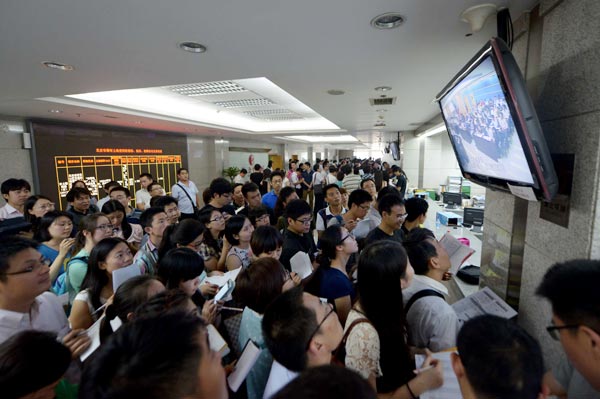How cities can go for the new normal
Updated: 2015-02-25 08:24
By Andrew Sheng and Xiao Geng(China Daily)
|
||||||||
 |
|
Representatives from property companies check offer prices at a recent land auction in Beijing. The capital city has seen a warm-up in its land market with sales reaching 191 billion yuan ($30.7 billion) this year. Provided to China Daily |
A new Deutsche Bank study says that last year, China's 300 cities faced a 37 percent drop in their land-sale revenues - which is a major setback given that land sales accounted for 35 percent of total local government revenues. Such revenues had risen at an average annual rate of 24 percent from 2009 to 2013.
Moreover, annual consumer and producer inflation dropped to 1.5 percent and minus 3.3 percent in December, owing partly to the sharp decline in world oil prices. China now faces deflation and an inhospitable external economic environment, and its urban centers are struggling with the complex interaction of solvency, liquidity and structural issues.
But some cities are better equipped than others to weather these challenges. China's first- and second-tier cities are very wealthy, benefiting from high property values and the continuous inflow of talent, capital, companies and investment projects. Despite a slowdown in the property market, Beijing's recent land auction concluded with record-breaking prices of about 38,000 yuan ($6,200) per square meter.
Third- and fourth-tier Chinese cities, however, face more challenging balance sheet adjustments, because of falling asset prices, outflows of labor and the need to define new growth models. In the aftermath of the post-2008 debt-fueled infrastructure-investment boom, these cities need to reform how revenue is shared with the central government, increase the transparency and accountability of local budgets, and overhaul the use of municipal-bond and public-private partnership models for local infrastructure projects.
But before such changes can be implemented, these cities must address the overhang of poorly performing projects and loss-making State-owned enterprises (SOEs). In fact, Chinese cities and local enterprises will need even more liquidity than would be required in a classic case of deflation, credit tightening and falling prices, because infrastructure and property investments by local governments and SOEs are still consuming funds. And, given State intervention, interest rates do not adjust quickly enough to allocate resources efficiently.
- Global health entering new era: WHO chief
- Brazil's planning minister steps aside after recordings revelation
- Vietnam, US adopt joint statement on advancing comprehensive partnership
- European border closures 'inhumane': UN refugee agency
- Japan's foreign minister calls A-bombings extremely regrettable
- Fukushima impact unprecedented for oceans: US expert

 Stars of Lijiang River: Elderly brothers with white beards
Stars of Lijiang River: Elderly brothers with white beards
 Wealthy Chinese children paying money to learn British manners
Wealthy Chinese children paying money to learn British manners
 Military-style wedding: Fighter jets, grooms in dashing uniforms
Military-style wedding: Fighter jets, grooms in dashing uniforms
 Striking photos around the world: May 16 - May 22
Striking photos around the world: May 16 - May 22
 Robots help elderly in nursing home in east China
Robots help elderly in nursing home in east China
 Hanging in the air: Chongqing holds rescue drill
Hanging in the air: Chongqing holds rescue drill
 2.1-ton tofu finishes in two hours in central China
2.1-ton tofu finishes in two hours in central China
 Six things you may not know about Grain Buds
Six things you may not know about Grain Buds
Most Viewed
Editor's Picks

|

|

|

|

|

|
Today's Top News
Liang avoids jail in shooting death
China's finance minister addresses ratings downgrade
Duke alumni visit Chinese Embassy
Marriott unlikely to top Anbang offer for Starwood: Observers
Chinese biopharma debuts on Nasdaq
What ends Jeb Bush's White House hopes
Investigation for Nicolas's campaign
Will US-ASEAN meeting be good for region?
US Weekly

|

|









